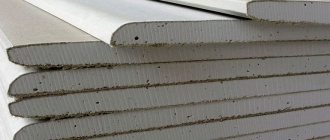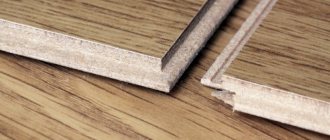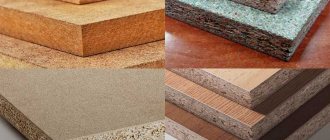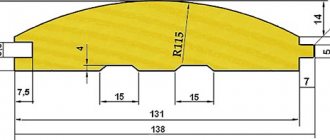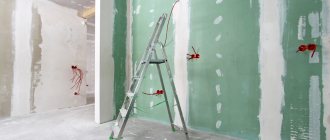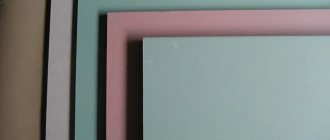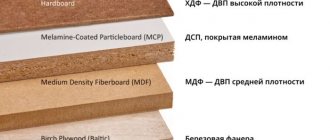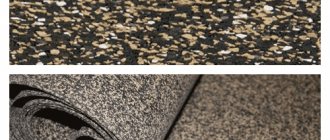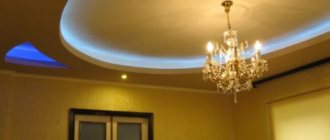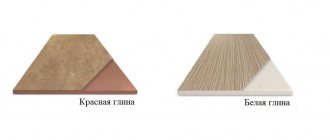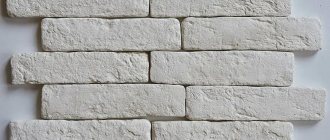Fiberboard and hardboard what is it
From wood processing waste, modern technical advances make it possible to produce many different types of slab samples. Since the raw materials are used of the same nature, doubts often arise among uninformed consumers: hardboard is fiberboard or chipboard. Let's look at the differences and features of these materials.
Hardboard what is it
For the production of chipboard, wood chips are the main raw material; for fiberboard, similar fibers are used. When figuring out what kind of material hardboard is, it is worth immediately noting that there are no patents for this type of building material. Technically, it belongs to the group of fiberboards made from wood. The subspecies is distinguished by the presence of one smooth side, often with a decorative component.
Hardboard-type canvases Source andraus.ru
Medium density fiberboard
Medium-density fiberboard, or MDF, is a type of semi-solid board. This is a relatively new building material that has taken pride of place among furniture makers and builders. This is because its density is 700-800 kg/m³, the strength is equal to that of hard fiberboard, which is almost twice as high as chipboard.
Laminate is made from medium density fiberboard (MDF).
Due to its ease of processing, MDF is widely used in the modern construction industry. The slabs are used to make platbands, baseboards, fillets, cabinet furniture facades, window sills, roof battens, and T-beams. They are used in the production of interior door panels. And fiberboard ceiling and wall panels of this category will be an elegant solution for room decoration. Laminate flooring is also made from MDF.
Having asked the important question of how much fiberboard costs, it is important to decide on the area of its further application. Here it is worth considering all the characteristics of each type and choosing the most optimal one, based on price and quality.
Overview characteristics of fiberboard
Hard and soft deciduous and coniferous trees, bast plants with a fibrous structure (reed, cotton, reed) can be used as raw materials. Phenol-formaldehyde resin, less often pine rosin (usually to strengthen soft boards) or organic isocyanates are used as a binder. Also, in order to adjust certain properties, add:
- repellents in solution with an aqueous alkaline emulsion (paraffin, ceresin, distillate slack);
- impregnation (on tall oil with the addition of driers, gossypol resin, recycled polyethylene or petroleum bitumen);
- precipitants (sulfuric acid, aluminum sulfate);
- flame retardants (nepheline with asbestos or phosphates, ammonium sulfates, boric acid or borax);
- antiseptics (ammonium silicofluoride, sodium pentachlorophenolate).
The table provides a description of the production technologies for standard fiberboard sheets.
| Stages | "Wet" method | "Dry" method |
| Preparation of raw materials | Chopped wood chips are sorted according to a number of parameters: no crushed lumps, length 10-35 mm, thickness up to 5 mm, cut 30-60 degrees. Acceptable content is 1% minerals, 5% rot, 15% bark. | |
| Humidity and strength of raw materials | Before grinding, the moisture content of the material is 50-70%, after - about 30%. To reduce the fragility of the fibers, the wood chips are steamed at +80-90 degrees Celsius. | |
| Forming the slab | The fibers are placed in a pool where the water content in the working mass reaches 98.2%. Next, the composition is filtered and squeezed. The residue on a mesh base is pressed at a temperature of 200-215 degrees Celsius, a pressure of 5-5.8 MPa. The raw materials go through three stages here: pressing, drying, hardening. | The canvas is formed in the air. The raw materials in the steaming chamber are irrigated with a binder solution. The carpet is pressed at a temperature of +220-260 degrees Celsius under a pressure of 6.5-7.5 MPa. Drying is carried out in 2 stages, finally conditioning with humidification and cooling. |
| Additional processing | After oil impregnation, solid slabs are subjected to heat treatment (+160-170 degrees Celsius). Soft sheets do not go through this stage. | Before the conditioning stage, heat treatment is carried out to increase the resistance of the boards to water and mechanical stress. |
Compared to the natural analogue, the fibrous analogue costs less, exhibits better flexibility or elasticity, and is easier to install without the risk of cracks. Also, the sheets weigh little and can be made of fiberboard in different sizes in the form of a seamless fabric. There is still one drawback - the narrow scope of application of a particular subspecies. For example, for walls or floors, rough cladding or decorative.
See also: Catalog of companies that specialize in finishing materials and related work
Classification and labeling
Unlike hardboard, fiberboard sheets, which are made using the “dry” method, have 2 smooth sides. Accordingly, materials are awarded categories “A” or “B”. The latter are considered more durable and resistant to moisture due to a larger number of different functional additives.
Finished fiberboard sheets have different standard sizes, appearance, technical characteristics and scope of application. Markings and main classification are given in the table.
| Subspecies | Decoding | Distinctive features |
| M | Soft | Porous, low strength. Based on density, three subtypes are distinguished and designated by a numerical identifier: 1, 2, 3. |
| NT or PT | Reduced hardness | Absorbs up to 40% moisture, exhibits good resistance to mechanical load, hard. |
| T | Solid | Swells from moisture by 20-25%. Durable boards with mechanical resistance. Additionally, materials are divided into groups “A” and “B”. |
| TS | Solid with a smooth or decorative side | |
| TP | Solid hardboard with painted side | |
| TSP | TS plus painted surface on the front side | |
| TV | Hard and moisture resistant sheet | |
| TSV | Solid, moisture resistant with fine wood finish | |
| ST | Super hard sheet | Moisture resistance of about 13% and 10%, respectively, increased density, high quality. |
| STS | Super hard board with decorative finish |
Additionally, varieties are determined. The 1st is characterized by the absence of visible flaws. Second, dents and scratches on the front side are acceptable, but do not affect the quality of the canvas.
The thermal conductivity of the canvas varies between 0.046-0.093 W/m*K. The density of soft fiberboard does not exceed 350 kg/cub.m. A cubic meter of NT or PT type sheets weighs from 850 kg, super-hard boards from 950 kg.
Brands of soft slabs and their thickness
- Soft slabs with different densities are classified by the following units: M-1, M-2 and M-3.
- The soft thin fiberboard sheet has a thickness of 2.5-40 mm.
- Semi-solid low-density fiberboard sheet has a density of 6, 8 and 12 mm;
- Semi-hard sheet with medium density has a thickness of 16 and 25 mm.
Thin soft sheets have both advantages and disadvantages. Semi-solid sheets of low and medium density are more suitable as insulating materials, but not for covering rooms.
With the correct selection of fiberboard, taking into account the types and sizes, you can facilitate the facing and construction work and save money.
Fiberboard sheet and hardboard sizes standard
Wood-fiber materials are in great demand in the construction market and in industry, especially by furniture factories. Therefore, the production of fiberboard is standardized in terms of sheet size and thickness.
Fibreboard sheet size width and length standard
The standard parameters of the slabs are regulated by GOST 4598 of 1986. In accordance with the regulatory document, the length can be from 1220 to 6100 mm, width - from 1220 to 1700 mm, thickness from 2.5 to 16 mm. The tables provide more detailed information on the standard sizes of fiberboard depending on the subgroup (in mm).
| Subtype of plate | Length | Width |
| Soft | 1220, 1600, 1800, 2500, 2700, 3000. | 1220. |
| Semi-hard - super hard | 1220, 1700, 1800, 2050, 2500, 2745, 3050, 3350, 3660. | 610, 1220, 1525, 1830, 2410. |
| Solid | 2140, 2440, 2745, 3050, 3355, 3660. | 1220, 1525, 1830, 2140. |
Peculiarities
Hardboard is not considered an independent nomenclature unit and is not separately regulated by state standards. This sheet woodworking product is a type of fiberboard, the manufacturing technology of which and quality standards fall under the standards of GOST 4598-86.
Compound
The material is based on wood waste products - wood fibers crushed to a minimum fraction. These components are mixed with an adhesive polymer composition and compressed under high pressure. The adhesive mass contains formaldehyde, which, when evaporated, is harmful to human health. The laminated coating, which is applied to some brands of hardboard, significantly reduces the harm from formaldehyde, preventing its evaporation and improving the properties of this material.
The composition of wood-fiber material includes a number of ingredients.
- Phenol-formaldehyde resins and polymer binders. They glue wood fibers together and also give the material high density and strength.
- Pectol (a product of processing the tall oil component), as well as other polymer compounds that increase the resistance of the material to mechanical stress.
- Antiseptic compounds that affect the resistance of wood fibers to the effects of fungus, mold and prevent decay processes. These additives also increase the material's resistance to moisture.
- Fire retardants are substances that give the material a certain fire resistance.
- Hydrophobic additives in the form of paraffins, rosin resin and others. The components provide the material with water-repellent ability.
According to the technical documentation, hardboard contains no more than 1.3% of astringent adhesive composition relative to the total mass of the material. In addition, only low-toxic components are allowed to be used in polymers.
Specifications
According to GOST standards, materials related to hardboard are divided into 3 main types.
- Soft hardboard, marked with the letter “M”. The weight of this material is small due to its low density, which is 100-500 kg/m². If you carefully examine the surface of the leaf, you will notice its porosity, like that of balsa wood. This type of hardboard is used for interior finishing work. With its help, they equip partitions, level the floor, ceilings or walls.
- Solid hardboard, marked with the letter “T”. Due to its high density, which ranges from 500 to 800 kg/m², the material is positioned as moisture resistant and can be used not only for finishing, but also for construction needs. Externally, this material looks like a solid sheet of technical cardboard. Moisture resistance is especially well expressed in varieties of this material that have a film lamination of the surface. Thick sheets are used for the manufacture of container boxes, as well as in furniture production.
- Super-hard hardboard, marked with the letters “ST”. Its density ranges from 800 to 1100 kg/m². The structure of this material has enhanced monolithic strength, so hardboard is used in the construction industry, in the production of furniture products, for the manufacture of interior doors and for other needs.
The most popular option is hardboard without adding any finishing components. This sheet of natural beige color is often used to make the back walls of drawers or cabinets; shipping boxes and other container products are made with its use, and is also used in construction and finishing works.
The resistance to moisture of different types of fibreboard varies depending on their density. For example, a semi-solid material marked with the letters “NT” can be in water for more than a day and at the same time swells by only 40%, while the super-hard type “ST” under the same conditions will swell by only 15%.
Fiberboard ceiling finishing
Such slabs are distinguished by the size and number of joints located on four sides. In a short time you can get a cozy and beautiful room by finishing the ceiling with hardboard. Fiberboard can also serve as additional thermal insulation, which is very important for houses with a cold attic.
The shrinkage of a house often leads to cracks appearing on the surface. It is not uncommon for plastered walls and ceilings to become covered with small cracks several months after repairs. This does not happen when using fiberboard to decorate a room.
The All-fanera company sells panel materials such as fiberboard, chipboard and MDF, various types of plywood, and also carries out sawing and cutting of materials to order. You can buy fiberboard and other materials at both wholesale and retail prices. The goods are also delivered and packaged to prevent damage.
Many people often confuse fiberboard and hardboard. In fact, these are the same material, except that hardboard is more durable. Hardboard sheets are familiar to most consumers: these are slabs up to 7 mm thick, with a characteristic rough “checkered” back side and smooth on the front side.
Production
Hardboard wood-fiber sheets are produced by pressing under high temperature conditions. The crushed wood fiber components are combined with a hot polymer adhesive. After thorough mixing, the composition is subjected to the action of a defibrator, which breaks down the components of the material in an explosive manner. After this stage, finished sheets are cast from the resulting composition in special molds, which are placed under a hot press with high pressure. The next stage of production is drying the sheets in a special drying chamber.
The hardboard production technology is somewhat similar to the MDF production method. The difference is that pre-steaming the fibers promotes their better splitting, which, in turn, makes it possible to produce even very thin sheets.
Area of use
Hardboard, both laminated and regular, has found wide application in the furniture industry. It is used to create the back walls of furniture if the product is not subject to too much load. In fact, it is an alternative to more expensive plywood; its use can slightly reduce the cost of cabinet furniture.
Used as a replacement for expensive plywood in cabinet furniture
This material is also used for drawer bottoms subject to a maximum load not exceeding 5 kg. Interior doors are also lined with hardboard and used as a decorative covering for furniture facades. Such products are classified as economy class. Due to its availability and fairly high strength, it is widely used in office and technical premises, and in social institutions. Another advantage of hardboard is its flexibility. Furniture facades having a radial shape are made from it.
Can be used as packaging material
Thanks to the ease of processing and a wide selection of monochrome colors or patterns that imitate natural materials, hardboard has found application in decoration and design.
Sheets without lamination are used for rough surface preparation. In particular, hardboard is used on the floor under laminate, carpet or linoleum. You can learn more about this from the video:
Watch this video on YouTube
